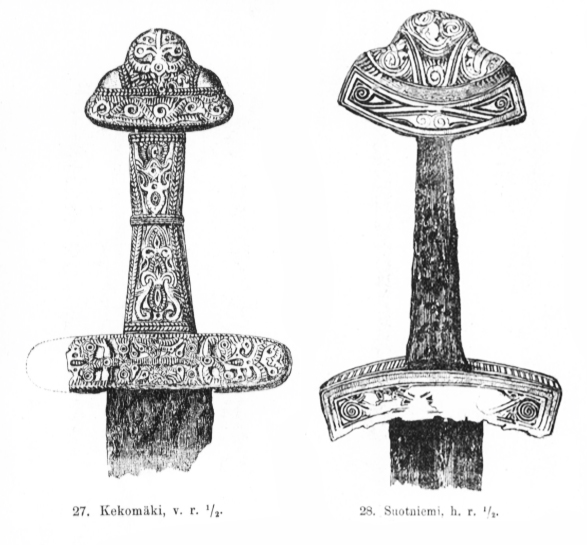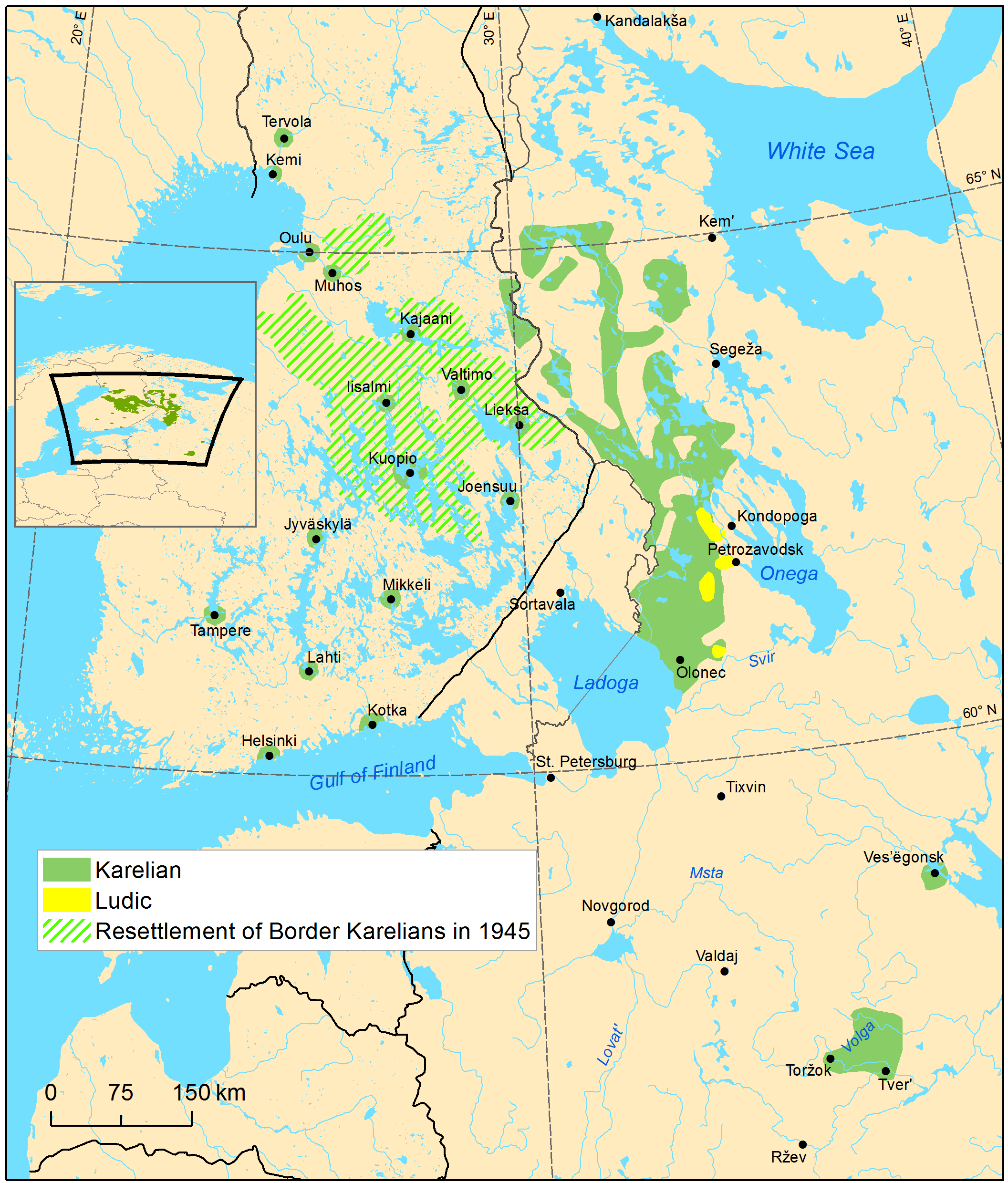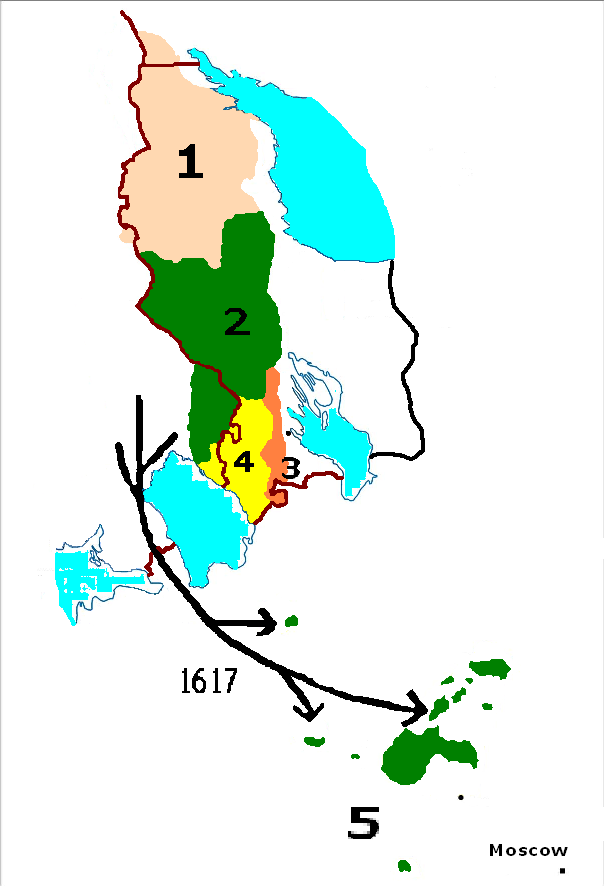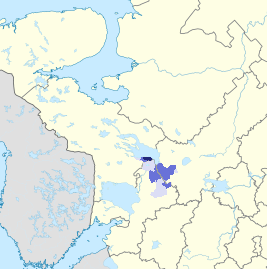|
Karelians
Karelians (; ; ; ) are a Baltic Finnic ethnic group who are indigenous to the historical region of Karelia, which is today split between Finland and Russia. Karelians living in Russian Karelia are considered a distinct ethnic group closely related to Finnish Karelians, who are considered a subset of Finns. This distinction historically arose from Karelia having been fought over and eventually split between Sweden and Novgorod, resulting in Karelians being under different cultural spheres. In Russia, Karelians mostly live in the Republic of Karelia, where they are the designated ethnic group, and in other adjacent north-western parts of the country. They traditionally speak the Karelian language and are Eastern Orthodox Christians. There are also significant Karelian enclaves in the Tver and Novgorod oblasts, as some Karelians migrated to those areas after the Russo-Swedish War of 1656–1658. In Finland, the term Karelian generally refers to the Finnish Karelians, who ... [...More Info...] [...Related Items...] OR: [Wikipedia] [Google] [Baidu] [Amazon] |
Karelians (Finns)
Karelians (, ), also known as Finnish Karelians or Karelian Finns, are a subgroup () of the Finnish people, traditionally living in Finnish Karelia. Karelians speak eastern dialects of the Finnish language: the South Karelian dialects are spoken in South Karelia, while the eastern Savonian dialects are spoken in North Karelia. The South Karelian dialects were spoken in the Karelian Isthmus prior to the Winter War. Karelians are traditionally Lutheran Christians, with an Orthodox Christian minority, belonging to either the Evangelical Lutheran Church of Finland or the Orthodox Church of Finland respectively. Eastern Kymenlaakso belongs to the historical region of Finnish Karelia, as the Kymi River served as the boundary between the Tavastians and the Karelians during the Middle Ages. However, the Karelian presence in this region during the Middle Ages was weak, and migration from western Finland during this time resulted in an ethnic composition more closely resembling that o ... [...More Info...] [...Related Items...] OR: [Wikipedia] [Google] [Baidu] [Amazon] |
Tver Karelia
Tver Karelia (; ; ) is the area inside the Tver Oblast that is inhabited by Tver Karelians, Karelians. Geography Refugees from the of the settled on the palace (state) lands of the and other parts of the , which were deserted due to the turmoil and oppression of the Time of Troubles; historically, these territories made up Tver Karelia. By the beginning of the 20th century, the largest number of Tver Karelians lived in Bezhetsky Uyezd, Bezhetsky, Vesyegonsky Uyezd, Vesyegonsky, Vyshnevolotsky Uyezd, Vyshnevolotsky, Novotorzhsky Uyezd, Novotorzhsky, partly in Tverskoy Uyezd, Tversky, Zubtsovsky Uyezd, Zubtsovsky, Kashinsky Uyezd, Kashinsky uyezds.ИСТОРИКО-ДЕМОГРАФИЧЕСКАЯ СПРАВКА According to the 1926 census, the Tver Karelians numbered 140,567 people, ... [...More Info...] [...Related Items...] OR: [Wikipedia] [Google] [Baidu] [Amazon] |
Republic Of Karelia
The Republic of Karelia, or simply Karelia or Karjala (; ) is a Republics of Russia, republic of Russia situated in the Northwest Russia, northwest of the country. The republic is a part of the Northwestern Federal District, and covers an area of , with a population of 533,121 residents. Its capital city, capital is Petrozavodsk. The modern Karelian Republic was founded as an autonomous republic within the Russian SFSR, by the Resolution of the Presidium of the All-Russian Central Executive Committee (VTsIK) on 27 June 1923 and by the Decree of the VTsIK and the Council of People's Commissars of 25 July 1923, from the Karelian Labor Commune, Karelian Labour Commune. From 1940 to 1956, it was known as the Karelo-Finnish Soviet Socialist Republic, one of the Republics of the Soviet Union, republics of the Soviet Union. In 1956, it was once again made an autonomous republic and remained part of Russia following the dissolution of the Soviet Union in 1991. Etymology "Karelia" deriv ... [...More Info...] [...Related Items...] OR: [Wikipedia] [Google] [Baidu] [Amazon] |
Karelia (historical Province)
Karelia (: ) is a historical province of Finland, consisting of the modern-day Finnish regions of South Karelia and North Karelia plus the historical regions of Ladoga Karelia and the Karelian Isthmus, which are now in Russia. Historical Karelia also extends to the regions of Kymenlaakso (east of the River Kymi), Northern Savonia ( Kaavi, Rautavaara and Säyneinen) and Southern Savonia (Mäntyharju). Karelia may also refer to the region as a whole, including the portion of Karelia within Russia. The term "Finnish Karelia" refers specifically to the historical Finnish province, while East Karelia or "Russian Karelia" refers to the portion of Karelia within Russia. Finland ceded a portion of Finnish Karelia to the Soviet Union after the Winter War of 1939–40. More than 400,000 evacuees from the ceded territories re-settled in various parts of Finland. Finnish Karelians include the present-day inhabitants of South Karelia and North Karelia, as well as the still-surviving ... [...More Info...] [...Related Items...] OR: [Wikipedia] [Google] [Baidu] [Amazon] |
Karelian Language
Karelian (; ; ; ) is a Finnic language spoken mainly by the Karelians, Karelian people in the Russian Republic of Karelia. Linguistically, Karelian is closely related to the Finnish language, Finnish dialects spoken in eastern Finland, and some Finnish linguists have even classified Karelian as a dialect of Finnish, but nowadays it is widely considered a separate language. Karelian is not to be confused with the South Karelian dialects, Southeastern dialects of Finnish, sometimes referred to as ("Karelian dialects") in Finland. In the Russian 2020–2021 census, around 9,000 people spoke Karelian natively, but around 14,000 said they were able to speak the language. There are around 11,000 speakers of Karelian in Finland, and around 30,000 people in Finland have at least some knowledge of Karelian. The Karelian language is a group of two supradialects. The two supradialects are Karelian Proper language, Karelian Proper (which comprises Northern Karelian dialect, Northern Kareli ... [...More Info...] [...Related Items...] OR: [Wikipedia] [Google] [Baidu] [Amazon] |
Finnish People
Finns or Finnish people (, ) are a Baltic Finns, Baltic Finnic ethnic group native to Finland. Finns are traditionally divided into smaller regional groups that span several countries adjacent to Finland, both those who are native to these countries as well as those who have resettled. Some of these may be classified as separate ethnic groups, rather than subgroups of Finns. These include the Kvens and Forest Finns in Norway, the Tornedalians in Sweden, and the Ingrian Finns in Russia. Finnish language, Finnish, the language spoken by Finns, is closely related to other Balto-Finnic languages such as Estonian language, Estonian and Karelian language, Karelian. The Finnic languages are a subgroup of the larger Uralic languages, Uralic family of languages, which also includes Hungarian language, Hungarian. These languages are markedly different from most other languages spoken in Europe, which belong to the Indo-European languages, Indo-European family of languages. Native Finns c ... [...More Info...] [...Related Items...] OR: [Wikipedia] [Google] [Baidu] [Amazon] |
Karelia
Karelia (; Karelian language, Karelian and ; , historically Коре́ла, ''Korela'' []; ) is an area in Northern Europe of historical significance for Russia (including the Soviet Union, Soviet era), Finland, and Sweden. It is currently divided between northwestern Russia (the Federal subjects of Russia, federal subjects of the Republic of Karelia and Leningrad Oblast) and Finland (the Regions of Finland, regions of South Karelia, North Karelia, and the eastern portion of Kymenlaakso). Use of name Various regions may be called Karelia. Finnish Karelia is a historical province of Finland and is now divided between Finland and Russia, often called just ''Karjala'' in Finnish. The eastern part of this chiefly Lutheran area was ceded to Russia after the Winter War of 1939–40. The Republic of Karelia is a Russian federal subject, including East Karelia, with a chiefly Russian Orthodox population. Within present-day Finland, ''Karjala'' refers to the Regions of Finland, ... [...More Info...] [...Related Items...] OR: [Wikipedia] [Google] [Baidu] [Amazon] |
Tver Oblast
Tver Oblast (, ) is a federal subject of Russia (an oblast). Its administrative center is the city of Tver. From 1935 to 1990, it was known as Kalinin Oblast (). Population: Tver Oblast is a region of lakes, such as Seliger and Brosno. Much of the remaining area is occupied by the Valdai Hills, where the Volga, the Western Dvina, and the Dnieper have their source. Tver Oblast is one of the tourist regions of Russia with a modern tourist infrastructure. There are also many historic towns: Torzhok, Toropets, Zubtsov, Kashin, Vyshny Volochyok, and Kalyazin. The oldest of these is Rzhev, primarily known for the Battles of Rzhev in World War II. Staritsa was the seat of the last appanage principality in Russia. Ostashkov is a major tourist center. Geography Tver Oblast is located in the west of the middle part of the East European Plain. It stretches for 260 km from north to south and 450 km from west to east. The area borders Yaroslavl Oblast in the east, ... [...More Info...] [...Related Items...] OR: [Wikipedia] [Google] [Baidu] [Amazon] |
Baltic Finnic Peoples
The Baltic Finnic peoples, often simply referred to as the Finnic peoples, are the peoples inhabiting the Baltic Sea region in Northern Europe, Northern and Eastern Europe who speak Finnic languages. They include the Finns, Estonians (including Võros and Setos), Karelians (including Ludic language, Ludes and Livvi-Karelian language, Livvi), Vepsians, Veps, Izhorians, Votians, Votes, and Livonians. In some cases the Kvens, Ingrian Finns, Ingrians, Tornedalians and speakers of Meänkieli are considered separate from the Finns. The bulk of the Finnic peoples (more than 98%) are ethnic Finns and Estonians, who reside in the two independent Finnic nation states—Finland and Estonia. Finnic peoples are also significant minority groups in neighbouring countries of Finns in Sweden, Sweden, Norway and Russia, especially Karelia. Theories of origin According to the "Migration Theory" that was based primarily on comparative linguistics, the proto-Finns migrated from an ancient homeland ... [...More Info...] [...Related Items...] OR: [Wikipedia] [Google] [Baidu] [Amazon] |
Baltic Finns
The Baltic Finnic peoples, often simply referred to as the Finnic peoples, are the peoples inhabiting the Baltic Sea region in Northern and Eastern Europe who speak Finnic languages. They include the Finns, Estonians (including Võros and Setos), Karelians (including Ludes and Livvi), Veps, Izhorians, Votes, and Livonians. In some cases the Kvens, Ingrians, Tornedalians and speakers of Meänkieli are considered separate from the Finns. The bulk of the Finnic peoples (more than 98%) are ethnic Finns and Estonians, who reside in the two independent Finnic nation states—Finland and Estonia. Finnic peoples are also significant minority groups in neighbouring countries of Sweden, Norway and Russia, especially Karelia. Theories of origin According to the "Migration Theory" that was based primarily on comparative linguistics, the proto-Finns migrated from an ancient homeland somewhere in north-western Siberia or western Russia to the shores of the Baltic Sea around ... [...More Info...] [...Related Items...] OR: [Wikipedia] [Google] [Baidu] [Amazon] |
Livvi-Karelian Language
Livvi-Karelian (Alternate names: ''Liygi'', ''Livvi'', ''Livvikovian'', ''Olonets'', ''Southern Olonetsian'', ''Karelian''; ) is a supradialect of Karelian language, Karelian, which is a Finnic languages, Finnic language of the Uralic languages, Uralic family, spoken by Olonets Karelians (self-appellation , ), traditionally inhabiting the area between Lake Ladoga, Ladoga and Lake Onega, Onega lakes, northward of Svir River. The name "Olonets Karelians" is derived from the territory inhabited, Olonets Krai, named after the town of Olonets, named after the Olonka River. History Before World War II, Livvi-Karelian was spoken both in Russia and in Finland, in the easternmost part of Finnish Karelia. After Finland was forced to cede large parts of Karelia to the USSR after the war, the Finnish Livvi-Karelian population was resettled in Finland. Today there are still native speakers of Livvi-Karelian living scattered throughout Finland, but all areas in which Livvi-Karelian remains a ... [...More Info...] [...Related Items...] OR: [Wikipedia] [Google] [Baidu] [Amazon] |
Vepsians
Veps, or Vepsians (), are a Baltic Finns, Baltic Finnic people who speak the Veps language, which belongs to the Finnic languages, Finnic branch of the Uralic languages. According to the 2002 Russian census, there were 8,240 Veps in Russia. Of the 281 Veps in Ukraine, 11 spoke Vepsian according to the 2001 Ukrainian census. The self-designations of these people in various dialects are ''vepslaine'', ''bepslaane'' and (in northern dialects, southwest of Lake Onega) ''lüdinik'' and ''lüdilaine''. Almost all Vepsians are fluent in Russian language, Russian. The younger generation, in general, does not speak Vepsian; however, many have an understanding of the language. Geography In modern times, they live in the area between Lake Ladoga, Lake Onega and Lake Beloye (Vologda Oblast), Lake Beloye – in the Russian Republic of Karelia in the former Veps National Volost, in Leningrad Oblast along the Oyat River in the Podporozhsky District, Podporozhsky and Lodeynopolsky Districts ... [...More Info...] [...Related Items...] OR: [Wikipedia] [Google] [Baidu] [Amazon] |








